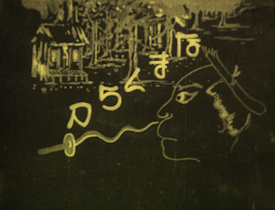The Dull Sword [the longest, digitally restored version]
| Original Title | なまくら刀[デジタル復元・最長版][白黒ポジ染色版] |
|---|---|
| Japanese kana Rendering | Namakuragatana |
| English Title | The Dull Sword [the longest, digitally restored version] |
| Production Date | 1917 |
| Author | Junichi Kouchi |
| Duration (minutes) | 4 |
| Sound | silent |
| Color | b/w, tinted |
| Plot | |
| Description | The following three works are said to be the forerunners of Japanese animation films: Hekoten Shimokawa's Mukuzo Imokawa - Genkanban no Maki (芋川椋三玄関番の巻), which was released in a series in January, May, and June 1917; Monkey and the Crabs (猿蟹合戦) by Seitaro Kitayama, and The Dull Sword (a.k.a. Hanawa Hekonai - The Famous Sword) (なまくら刀) by Junichi Kouchi. Of these three, the only existing film was a two-minute version of The Dull Sword, which was digitally restored in 2008 with the cooperation of Natsuki Matsumoto, a visual culture historian, from a tinted nitrate positive (yellow) owned by Matsumoto. This version (publicly presented at Cinema: Lost and Found 2008) had been believed to be nearly the same as the original version. However, the research described below revealed that it is mostly the second half of the original, while a newly discovered [2014] tinted nitrate positive (green) is composed mostly of its first half. The most important factor that motivates film restoration at NFC is the discovery of a work not stored here yet that played an important role in film history. The tinted nitrate positive (green) of The Dull Sword was included in the Nankoin Collection, which was officially donated to NFC in FY2008. The footage was inserted between a fragment of an animation in which a line is drawn gradually to complete a pot and a fragment of a live-action film of a man trick riding a bicycle (the titles of the two films are unknown). The part omitted in the previously restored version was hidden in the NFC collection. The first issue we encountered when reconstructing The Dull Sword (longest digitally restored version) was figuring out which and how many frames to choose from the previously restored version (yellow) and the newly discovered tinted nitrate positive (green) as source material for restoration. The two versions often complement each other, frame by frame. Consequently, creating a fully restored version might cause the color of the animation to change alternately between green and yellow within a brief single cut, which could be confusing to the audience. Fortunately, however, only several frames were missing consecutively from the two sources. Therefore, judging that it was possible to restore a nearly perfect version, we adopted the policy of using all 3,180 of the newly discovered frames and making up for missing parts by using the 810 frames found in the previously restored version. More specifically, we decided to use frames from the previously restored version in the following three parts of the film: (1) the main title "The Dull Sword"; (2) the intertitle "Let's try out the sword," which was turned clockwise by 90 degrees; and (3) from the scene where the samurai (Hanawa Hekonai), attacking a blind person from behind with a sword, is counterattacked, until the end. The two sources (one tinted in yellow and the other in green) differ in color as well as in tone and quality. Therefore, the next issue was how to mitigate the difference between them by digital restoration and reduce incongruities in appearance. Parts of the tinted nitrate positive (green) close to the core were already beginning to melt due to deterioration caused by aging. We, however, adopted the policy of using as much of the newly discovered version as possible, and of avoiding forcibly adjusting the two sources' image tones and qualities that were difficult to unify, including the part shifting to a scene ((3) above) in the previously restored version. For that reason, we decided to leave most of the respective characteristics of the two materials, keeping digital alteration to a minimum. Eventually, we adopted the following workflow for restoration: For the three parts that require the previously restored version, we used the digitally restored data (Digital Source Master, DSM) created in 2008. For the first half that requires the newly discovered version, we prepared a black-and-white internegative and then scanned it at a 2K resolution to digitally remove dirt and scratches, stabilize it and eliminate flickering etc. We then conformed (edited) these two sets of digital data and created a new DSM after grading (color adjustment) to record it into a black-and-white negative. After completing the above digital restoration work at IMAGICA, we tinted the previously restored version in yellow and the newly discovered version in green at IMAGICA West, which has an abundance of know-how in tinting black-and-white prints by using the same tinting method as was used during the silent film era. Finally, we completed the longest version print for public screening by splicing these positives. The longest digitally restored version (4 min. at 16fps) of The Dull Sword, which challenges its conventional version, was thus completed. The Dull Sword was rated highly in Katsudoshashin zasshi (活動写真雑誌), a film magazine of the time. Nevertheless, a particularly long scene in which the samurai purchases a sword for four gold coins from Swordsmith Namakuraya's head clerk, whose craftiness is revealed in his movements, has never been seen before. The scene where a gold coin flips in the air was criticized as being too "drawn out" at the time when the film was publicly released. However, having discovered and restored the valuable animation, this scene develops at a tempo needed to prepare for the second half of the film, in which developments occur more quickly."Considering the width of lines used in the animation, Hekonai Haniwa's New Sword (塙凹内新刀之巻[sic]), one of the new works produced by Kobayashi Shokai, seems to have been conceived from Universal’s Dekobo's Sketchbook. Overall, it is a nice piece of work. However, the movements of the coin in the air and the scabbard are slightly drawn out. This is because of the number of frames used in filming," writes Kyokko (Kyokko Yoshiyama, by the author) in "Brief Comment on Picture," Katsudo Shashin Zasshi September 1917 issue. Seeing the whole picture of The Dull Sword also enabled us to confirm that the previously restored version has an introduction-development-turn-conclusion story structure like a four-frame comic strip: (1) the animation starts with an iris-in immediately after the main title (introduction); which is followed by (2) the scene where the samurai purchases a sword for four gold coins from Namakuraya's head clerk (development); (3) the samurai attacks a blind person from behind to test his sword and is kicked by the blind person (turn); and finally, the film changes into a silhouette, in which (4) the samurai is defeated by a courier (conclusion). The previously restored version (2 min.) contains all of these scenes. In the previously restored version, the introduction and the development last only a few seconds; in the newly discovered version, in contrast, these scenes are greatly expanded. The movements unique to stop animations as well as the free expressions in intertitles indicate the high level of perfection of the oldest existing frame shooting animation. These elements develop against the backdrop of the solid story structure discussed above. (Masaki Daibo, " Multiple Versions and the recent achievements of our digital restoration," NFC Newsletter, No. 117, 2014, pp. 2-3) |
| Production Company | Kobayashi Shokai Ltd.* |
| Distribution | |
| Release Date | Jun 1917 |
| Credits: Director | Junichi Kouchi* |
| Credits: Staff, Cast, etc. | |
| Intertitles | T1「なまくら刀」、T2「御刀劔師 なまくらや」、T3「サア 何か 斬って…」、T4「こゝで一番試斬り」、T5「人殺シ――-」、T6「Y. N. & CO.」。 |
| Censorship - Date and Number | |
| References | ・ "Japanese Movie Review: Totsubo's New Sketchbook, Trying a New Sword," Katsudo no Sekai, September 1917, p. 27. ・ "List of Films Released Each Month (Films Released in Japan): Animation Hanawa Hekonai – The Famous Sword," Katsudo no Sekai, September 1917, p. 162. |
| Frames per Second | 16fps |
| Source of Digital Copy | ①The 35mm nitrate positive tinted in yellow owned by Natsuki Matsumoto -> 35mm color internegative -> scanning ②The 35mm nitrate positive tinted in green owned by NFC -> 35mm B/W internegative -> scanning ①+② -> digital restoring -> 35mm B/W internegative(2K recording) -> 35mm B/W positive (tinted) |
| Completeness | complete |
| Additional Notes | The mark of "*" will provide an additional explanation gained from the bibliographical information. |
| Related Links |
Related categrory
Main characters
Please tell us what you think about this website by filling out a short questionnaire.
To educational users: Please provide us with feedback on website usage for educational purposes.
- Unauthorized copying and replication of the contents on this site are prohibited.

